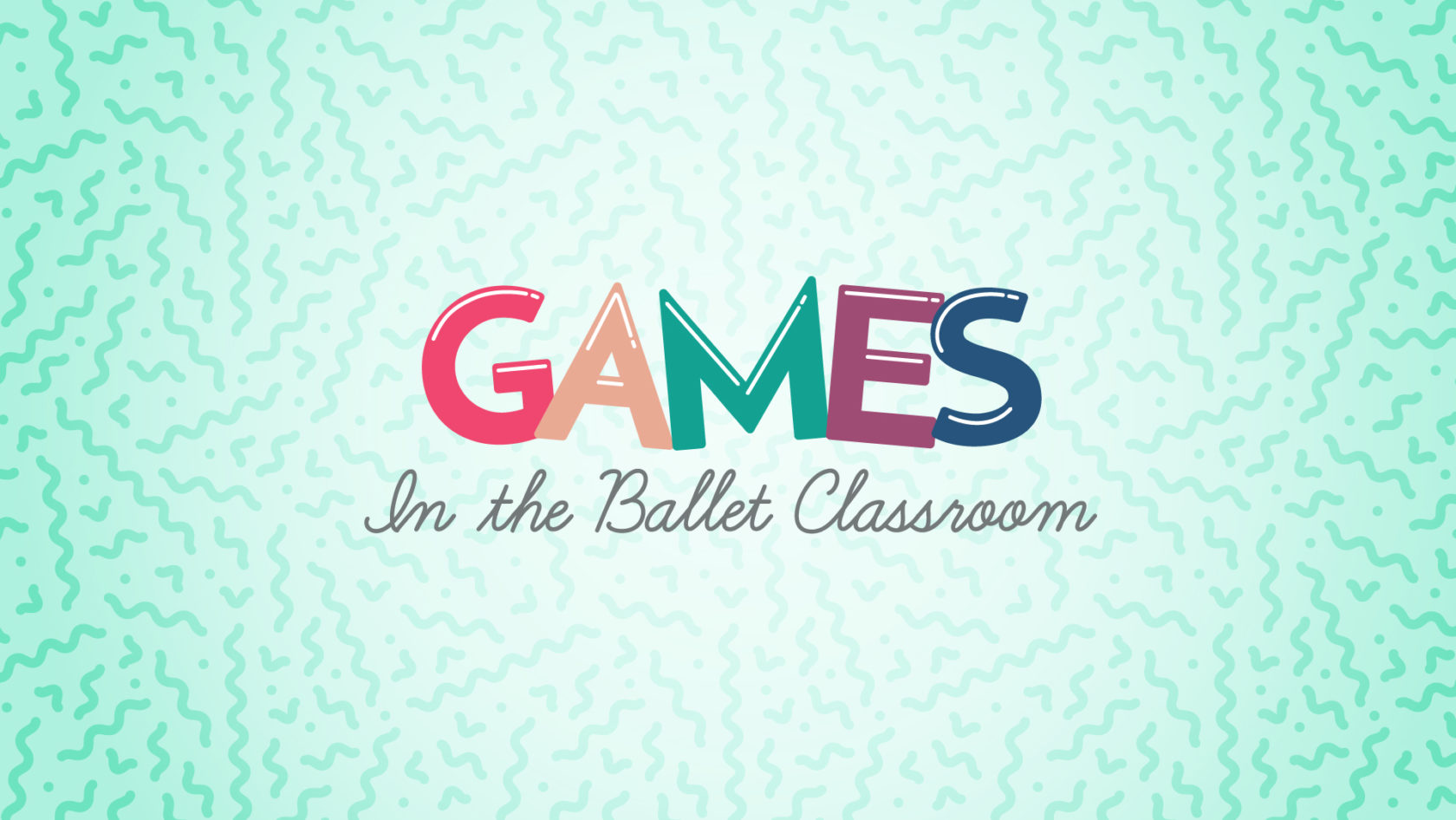It’s not just a suggestion, it’s pretty much a tried and true fact that children need to have at least one short break during their 45 minute to 1 hour ballet class. Most children between the ages of 3 to 9 actually have a really rough time staying attentive unless they are given some time to sit and rest for a few minutes (what I like to call “Talking Time” or “Story Time”), or sometimes they just need to rest their brains for a little while and do something fun!
To be clear, I’m not an advocate of playing games in class too often. Not even every week, I would say. Games are a good break from the routine, but should not be expected, as they can be a waste of valuable class time. This is not to be misunderstood as a way to better “babysit” your students or provide entertainment.
The following games are from Ruth Brinkerhoff’s “Ballet Is Spoken Here!” teacher manual (still in the works, but soon to be released by The Ballet Source). These are not just “Red Light, Green Light”, “Freeze Dance” or “The Hokey Pokey” type dances, either. They are dances that will actually help your students learn and understand ballet concepts. Enjoy, and pass it on to other teachers!
Umbrellas For The Toes
This is a visual image to help with keeping feet and knees in alignment. Tell the students: “Imagine that your knees are umbrellas, and that they must keep the rain off your toes when you do a Demi Plié or a Fondu. Don’t let your toes get wet!”
I have used this idea with students of all ages with good results. Even beginning adults find this visual image helpful.
Looking Through The Window
This fun activity encourages young dancers to turn out for Demi Plié:
Arrange the dancers in three lines in the center of the room. The middle line stands, as they are going to do the Demi Plié. The front line sits and faces back. That back line sits and faces front.
As the middle line does Demi Plié in First position, the dancers in front and back wave at each other through the “window” of the Demi Plié. After four Demi Pliés, another line takes a turn in the middle.
The Demi Plié Box
Young children enjoy doing the Demi Plié in First with their feet placed around the corner of a large box. They can hold onto the top of the box for balance. (Someone will need to hold the other side of the box to steady it.)
This makes their knees go out over their toes. The feet are turned out to make “the corner of a box”, or 45º, and placed with the inside edges of the feet in full contact with the box.
Looking Over The Fence
For Demi Pointe, or Elevé, dancers can imagine they are rising to look over a fence. What did they see (in their imagination) on the other side of the fence?
Maybe they saw some flowers. What color? What kind? Maybe they saw a puppy. What was it doing?, etc. This might make the practice of Elevé more interesting.
Demi Soloists
Have partners do a Port de Bras mirroring each other. Assign the Port de Bras, or have one partner lead and the other follow. When they get good at working together, it will be hard for the rest of the class to tell which partner is leading!
Climbing The Mountain
Port de Bras is difficult when there is not a clear image in the mind of exactly where the arms need to go. Students need to be able to visualize the positions, and the pathways between.
Having a visual image of something concrete and familiar helps performance and memory. The image of a mountain can help students learn a difficult concept: the pathway of a Classical Port de Bras. What seems so easy to us teachers can be very hazy and confusing to students because of their limited experience with Ballet.
The front of the mountain is steep. You will need climbing gear. You will need to sky dive or use climbing gear coming down the front. The sides are gentle slopes. You can walk up easily, and you can slide or ski down.”
Climbing up the face of the mountain, then sliding or skiing down the two sides of the mountain makes the normal pathway of a Classical Port de Bras. Climbing up the sides of the mountain, then sky diving down in front makes the pathway of the Reverse Port de Bras.
Can You Hear the Step?
Clap the rhythms of a Chassé Coupé, a Balancé a Glissade and a Pas de Bourrée. Each has its own rhythm pattern. Glissade and Chassé Coupé have a similar meter, but the accent is in a different place. The other two are quite different. Balancé is a 3/4 meter with three even steps: “one, two, three.” Pas de Bourrée is intended to be danced as a triplet rhythm with two upbeats: “and a one.”
- Practice with the class until they can clap the rhythms with you.
- You clap a rhythm, and the class dances the step as you clap.
- Divide the class in half. Half will clap a rhythm (chosen by them, or by you), and the other half must fit the correct step to the claps.
You can also do a version of this exercise with your younger ones using the beats for marches, skips, gallops, the polka, etc.
Clap and Dance
Clapping to the music may help students to dance the step on the music. Give them strong guidance (clap with them) until they are able to do it correctly alone.
- The class claps the rhythm of one of the steps with you, to the music, for 8 measures.
- You continue clapping with the music while the students stop clapping and dance the step for the next 8 measures.
- You also stop clapping as they dance the step for another 8 measures. Tell them to continue to “hear” the claps in their head on this last part.
Note: Some students may not realize that the clapping sounds represent the instant at which their feet connect with the floor! Quite often those with little or no Ballet experience will assume they are to be in the air on the claps. You may want to review this concept with your class before playing either of the above clapping games.
What are your favorite classroom games and activities? Submit your suggestions in the comments below.
Related Articles


Comments
Dianne says
Thank you for sharing! There are some lovely ideas here. I appreciate the visual imagery. I am sure the children will too.
Cindy Hedges says
when will this resource be available for purchase?
Angela says
Thank you for the lovely ideas. With my 3-5 year olds, I try and create a little story for every exercise- Like: somedays we will be cinderella and we want to show off our beautiful glass slippers (tendus) and then hide them away quickly (in first) before the wicked step mother sees us. This really helps the girls to pull up there legs in first position as the close after a tendu. We also usually end class with a free movement exercise. We have a big bunch of ribbons at the studio and the girls get to choose there favourite colour and move freely. They absolutely love looking at themselves in the mirror while doing this too ;) they also choose their character according to their ribbon colour. If they have a blue ribbon they could be Elsa from frozen or if they have the pink then they could be Barbie. It always amazes me the amount of imagination children at this age have. I find it so refreshing to see :)
i says
teach me how to dance ballet
Layla! says
So hi I really want to learn how to do ballet so I was hoping there would be some ballet stuff on here so I hope there is. BYEEEE!!!!
jillianne says
i always learned these five positions
Layla Horner says
I all ready do it
RAyna says
Thank you so much for these tips! I am teaching a dance class this upcoming year and I was trying to come up with some games to give the kids a little break in between our learning sessions. I will definitely be using someof these ideas! Thx again they were very helpful!
Kathe says
Awesome ideas, thank you!
Jessica is here says
Thank you for the Good ideas from here.
girafarig312 says
At my ballet school, we are a very professional classical ballet school. All of the hour and 15 minutes are used. There are no games in between. My teacher sometimes stops to tell us about how to do stuff correctly, but still no games. It just surprises me that ballet schools/studios will take time to play games. In my opinion, the whole class time should be learning, not playing games.
MP4 JUICE says
I loved the suggestion to use 'Simon Says' to reinforce proper ballet alignment! I've used this game with my students and it's been a huge hit - they love the challenge of following instructions while staying in proper form!
YTMP3 says
I absolutely love the idea of incorporating games into ballet class! It not only keeps the atmosphere light and fun but also encourages creativity and teamwork among the dancers. Can't wait to try out some of these suggestions in my own classes!
Vedu Apk says
I absolutely loved this post! Incorporating games into the ballet classroom is such a fun way to keep students engaged and excited about learning. The ideas you shared are creative and seem easy to implement. Can't wait to try some of these out in my next class! Thank you for the inspiration!
55Club says
I loved the suggestions in this post! Incorporating games into the ballet classroom sounds like a fantastic way to keep students engaged and learning. Can't wait to try some of these ideas in my own classes!
99 Club Login says
This post is incredibly helpful! I love the idea of integrating games into the ballet classroom to keep dancers engaged and motivated. The suggestions you provided are creative and fun, and I can't wait to try them out in my own classes. Thank you for sharing these great resources!
tiranga game login says
I absolutely love the idea of incorporating games into the ballet classroom! It makes learning so much more fun and engaging for the students. Can't wait to try out some of these suggestions with my class. Thanks for sharing!
tc lottery app says
I absolutely loved the ideas shared in this post! Incorporating games into ballet class sounds like a fantastic way to engage students and make learning more fun. Can't wait to try out some of these activities in my next class!
101 game login says
I absolutely loved the games you suggested for the ballet classroom! They seem like a fun way to engage students and make learning even more enjoyable. Can't wait to try them out in my next class! Thank you for the creative ideas!
Add Comment